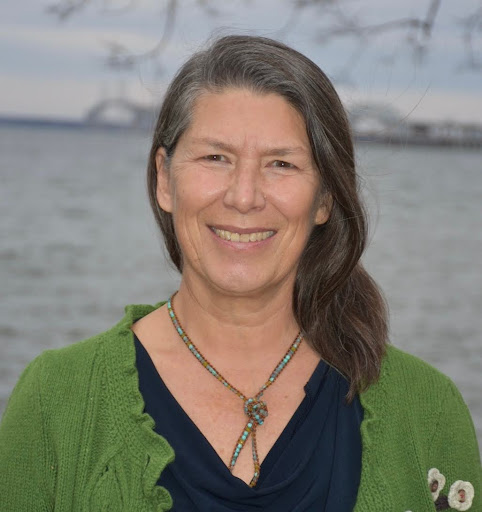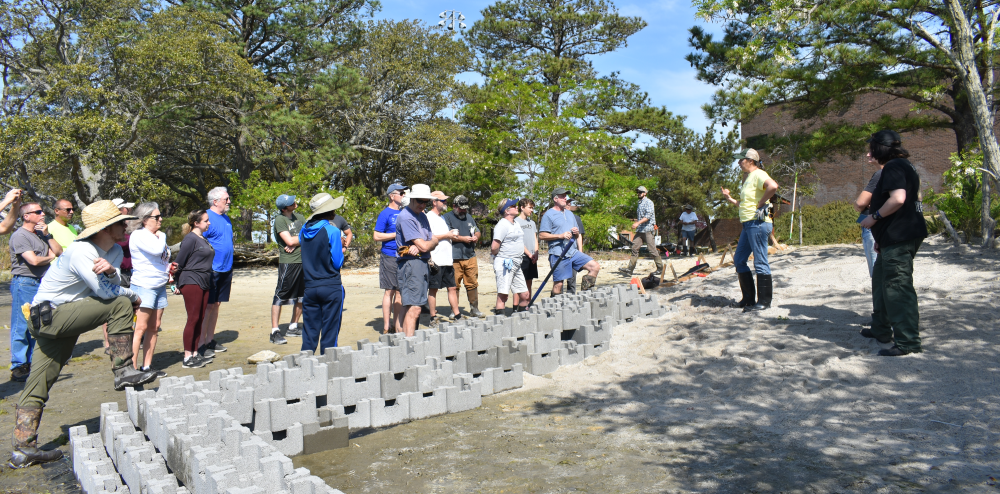
Q: Can you tell me a bit about your background?
A: I grew up in Arlington, Virginia, but started out on the West Coast, in college beach towns of Southern California. I have always loved being on and in the water and outside. Many of my early, happy memories are associated with exploring tidal pools, swimming, walking on beaches, along creeks, and in the mountains, collecting shells and rocks, and walking through the native, sun-crisped meadows, spotting cool plants or picking and eating fruit encountered along the way. This love of nature makes me passionate about conserving nature and clean water for all to benefit and enjoy.
I earned a BS in Geology in 1982 from James Madison University and worked as hydrogeologist and environmental consultant until 2001. In the late 80’s, seeking to explore a more creative profession, I earned a certificate of Landscape Design from George Washington University, and ran my own environmentally friendly landscape design business for a while. When we moved to Williamsburg, Virginia in 2001, I became a planning commissioner in James City County, where I discovered green or what Wetlands Watch now calls “living” infrastructure as an environmentally friendly way of planning and stormwater management and was hooked because it allows me to blend my passion for environmental conservation and preservation with my professional expertise gained as an environmental consultant, landscape designer, and planning commissioner.
Q: Can you explain a bit about what your home organization does?
A: Wetlands Watch is a small but mighty environmental non-profit that is working to help design and implement climate change adaptation measures throughout Virginia. Now in our 23rd year, we pursue this work by forging innovative partnerships across the nonprofit, for-profit, academic, and governmental worlds. By ensuring that the decision makers on the front lines have the information and training they need to succeed, and that the academics and public policy wonks understand what is actually happening on the ground, and that there are enough well-trained people doing the work, we ensure that Virginia’s climate adaptation solutions are effective, efficient, and in the long term best interests of local residents.
Because adaptation work is presently being pursued from the individual, neighborhood, and local levels all the way up to state and federal, Wetlands Watch works at all of these tiers simultaneously. At the most fundamental level, we educate Virginia residents and contractors about the nature and reality of climate change impacts and how to adapt to them. On the neighborhood level, we empower communities to develop cutting edge solutions to climate change impacts in ways that safeguard each community’s values and dreams for the future. On the local level, we ensure that locality staff have the knowledge and training they need to design, implement, and fund adaptation programs. Finally, we work with state and federal officials to design policies that best serve Virginia’s diverse communities.
In a nutshell, Wetlands Watch envisions a future in which community members, local government staff, for-profit businesses, neighborhoods, state government officials, and elected representatives work together to ensure that Virginia’s communities flourish in a changing climate.
In our work, we systematically support and promote living infrastructure: the conservation of open space, conservation landscaping, riparian buffers, nature-based stormwater practices, and living shorelines. Wetlands as living infrastructure provide communities with a host of benefits like flood mitigation, erosion control, stormwater management, habitat restoration, and increased water quality. As this is so, we are particularly focused on supporting policies and plans that protect and restore wetlands, and allow for wetland migration as the seas rise. Virginia has lost 42% of its original tidal wetlands, and is predicted to lose 89% of what remains by 2080 if we fail to act.
All of Virginia’s communities are experiencing high intensity rainfall events, and are increasingly at risk of extreme flooding events. As this is so, we work with communities throughout Virginia to adapt to these changing conditions by restoring wetlands, creating riparian buffers and greenways, and engaging in reforestation projects.
Q: Can you explain a bit about what your role is within your organization?
A: I have been with Wetlands Watch as Assistant Director since 2010. My role at Wetlands Watch has been to lead living infrastructure related projects, programs, and training, and to ensure that our mission and primary resilience goals of wetlands migration are communicated and integrated into all our programs, projects, and collaborations. At Wetlands Watch, we look for gaps in policies, plans, funding, programs, knowledge, and skills that influence the acceptance and use of living infrastructure and wetlands migration in communities, then develop programs or build coalitions to address those gaps.
At Wetlands Watch, I lead collaborative planning and development of projects and programs like the Virginia Beach Sea Level Rise Listening Sessions, the Chesapeake Bay Landscape Professional (CBLP) program, and the Wetlands Watch/Virginia Sea Grant Collaborative Resilience Research and Design Laboratory or “Collaboratory”. Because of my professional trusted relationships and experience convening and working in mutually supportive partnerships like the LSC, I am often asked to serve on steering committees, engage other stakeholders including private contractors and lead new CBLP training program development like the CBLP-Shorelines professional development and certificate series piloted and launched through the LSC NFWF grant. Every year, I also work on one or two Collaboratory resilience design projects with University classes and local underserved communities. Many of these projects are in the James River Watershed and provide resilience strategies for communities like the Aberdeen Gardens Community Resilience Action Plan.
Q: How did you first become affiliated with the LSC?
A: The short answer is Amber Ellis (JRA’s Restoration Director) asked and we said yes because we like working with JRA. When JRA first planned to pursue the first LSC NFWF resilience grant, Amber reached out to me because of our relationships and resilience work in Hampton Roads and throughout Virginia. Amber asked Wetlands Watch and myself for recommendations on potential partners to plan and implement living shoreline projects and other resilience projects. We started out on the steering committee and planned and ran living shoreline workshops designed to engage and recruit contractors and property owners to implement living shorelines. As the Virginia Coordinator for the CBLP program, we recruited CBLP certified contractors to attend those early training workshops.
Q: Why did you choose to work with the LSC?
A: We, Wetlands Watch and I, believe in the Collective Impact approach to achieving common goals where partners collaborate and align their actions in a mutually supportive arrangement. We started working with the LSC because Amber asked, and we trusted JRA as a partner and Amber as a convener. Knowing that JRA understands and values collaboration and has achieved results in other areas of the watershed, we felt that the energy and positive relationships built through the LSC would empower us all to achieve our shared goals of conserving nature and resilient shorelines in Virginia.
Q: How has your affiliation with the LSC affected your role and/or the impact of your organization on the geographic area you serve? What is your role in the LSC?
A: I share the role of steering committee member and training team lead with Stacie McGraw, Wetland Watch’s new Green Infrastructure Director and CBLP VA Co-Coordinator. Wetlands Watch has been committed to sharing information about the LSC and engaging new LSC partners beyond the James River Watershed and has informed event planning like the summits and in-person meetings.
Q: How have you and/or your organization benefited from the work being done by the LSC?
A: Wetlands Watch has been engaged in promoting living shorelines since before I started in 2010; however, working with the LSC, has done an amazing job of aligning and coordinating living shoreline outreach, engagement and implementation that we could not have achieved by ourselves. The LSC has provided Wetlands Watch with a means of doing our part to increase implementation of living shorelines as a wetlands migration and resilience strategy and address and overcome some of the barriers to living shorelines. One long-identified barrier has been the lack of trained and motivated living shoreline contractors. The LSC partnership has provided Wetlands Watch and CBLP with the funding, technical support, resources, and instructors to develop and pilot the CBLP-Shorelines program.
Q: What do you hope to accomplish with the LSC in the future?
A: In 2024 and beyond, we hope to support the sustainable growth, funding, and function of the LSC. We hope to establish a regularly offered CBLP-Shorelines workshop and increase the interest and availability of more trained contractors and professionals to support the implementation of living shorelines and bring more Wetlands Watch staff into the LSC to grow their knowledge and cultivate their skills, interest, and energy towards living shoreline implementation and training. We also hope to develop and pilot some training modules to grow understanding and support for living shorelines among decision makers and influencers. And finally, we would like to combine messaging and funding for riparian buffers and living shorelines because all living shorelines should have inland connectivity to riparian buffers to ensure the shoreline ecosystem can adapt with sea level rise.

